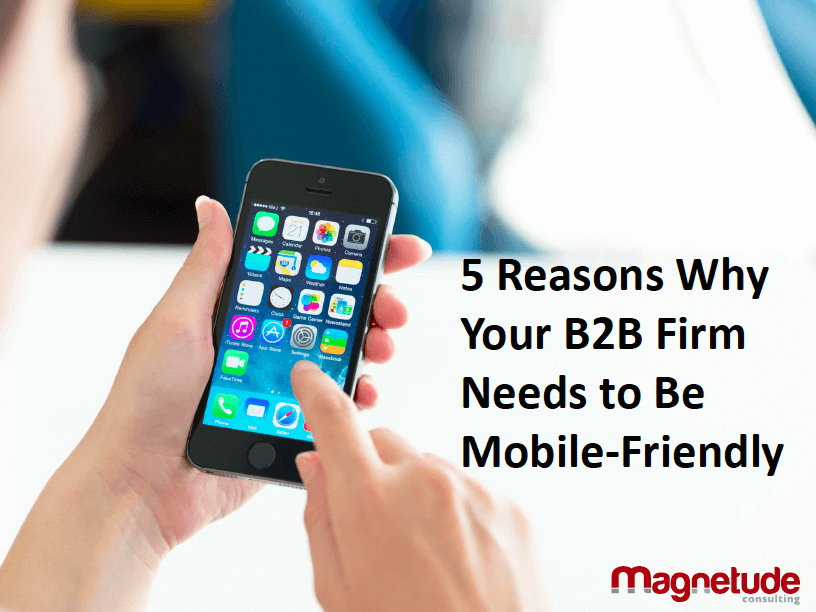5 Ways to Make Your B2B Firm More Mobile-Friendly

Let’s face it. In today’s world, we spend a lot of time on our mobile devices. In fact, recent studies have shown that on average, Americans spend more than 3 hours a day on their smartphones and tablets. By now, it’s a foregone conclusion that B2C companies have no choice but to embrace the mobile revolution. But what about B2B? Surely, your target prospects would be engaging with you at work on their desktop computers, right? Not necessarily. With professionals staying connected 24/7 and traditional 9-5 work hours becoming a thing of the past, your business may actually lose business if you don’t jump on the mobile bandwagon.
Understand the Mobile Business User
Professionals who use mobile for business are typically on the go or in between tasks or meetings. They often are searching for specific, rather than general information, such as an address, directions, a phone number or specs on a particular product or service. They also tend to bail if information is too difficult to find or requires too much searching. While these are behavioral generalizations across businesses, you should also consider outlining the use cases and personas for interacting with your company through mobile. Therefore, the two most important factors to consider when catering to a mobile business user are speed and a friendly user interface. Knowing this will have a significant impact on how you prioritize your online mobile presence.
Rejuvenate your Website
Once you understand more about your mobile users, the first place to start (generally speaking) is with your website. A recent survey found that up to 15% of B2B website visitors come from mobile devices. While it may not be worth the investment to create a completely separate mobile site, updating your current website with responsive design can be a cost effective way to optimize for all mobile devices.
Repurpose Your Content
Once you’ve created a website with responsive design, it’s time to think about your marketing and sales content. Depending on your content marketing program, you may already have an array of well-written thought leadership and sales-oriented content on your website dedicated to your target audience. While assets like whitepapers and case studies are valuable pieces of content, prospects visiting your site with their smartphones are most likely not interested in reading long, text-heavy documents. For the mobile business user, rich media is an excellent alternative to written content. For instance, turn your whitepaper or a recent blog post into a podcast.
Optimize your Email Campaigns
Almost half of all emails are opened on mobile devices. Whether your company does email marketing for brand awareness, demand generation, or customer engagement, your campaign performance could be dramatically impacted by optimizing for mobile.
Not only should your email templates incorporate responsive design, but they should also incorporate a number of other best practices that are easy to implement for mobile:
- Keep your subject lines below 60 characters
- Keep the body of your emails short and concise
- Use larger font sizes. Apple recommends anywhere from 17 -22pt.
- Limit the use of images for faster load times
- Make links or buttons easily clickable by thumb
Become App-Centric
On average, smartphone users spend up to 80% of their time in apps and only 20% of their time in a web browser. For some small tech firms, this means it may be time to create your own mobile app. When considering whether a mobile app is right for your business, ask yourself the following questions:
- How does my target audience access information?
- How do my current customers engage with me?
- Could a mobile app benefit my current employees or save time and resources?
- Could creating a mobile app close a gap in my customer service?
If the answers to at least one of these questions points to a mobile app, it may be time to discuss your mobile strategy.
These days, business professionals are seeking an immersive online experience that incorporates mobile, and expectations are shifting such that B2B tech companies need to show their value across platforms and devices. If you’re not sure how much time to invest in this transition, start by asking your customers. Find out what percentage of the time they spend engaging with your company on a mobile device and in what capacity. Drawing insights from current clients or customers is the starting point you’ll need to make more informed decisions about incorporating mobile for your company in the future.